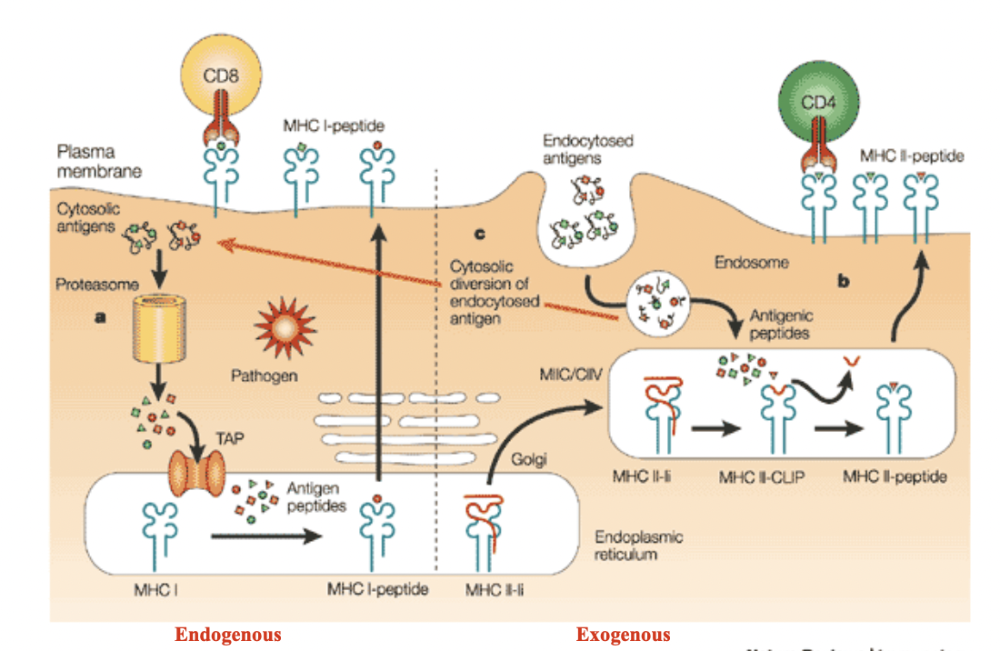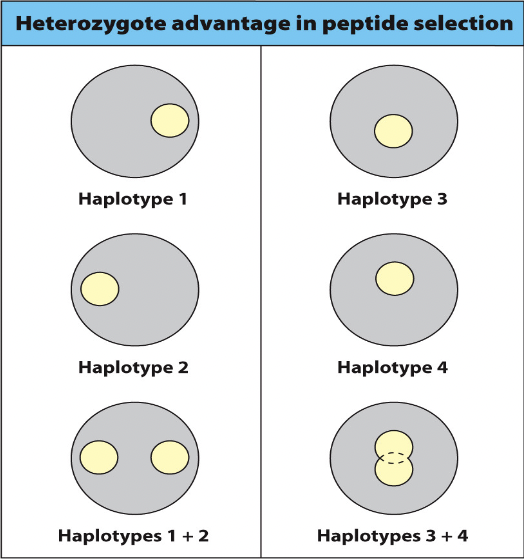Explain the details of how peptides derived from an Endogenous protein are generated and presented by an MHC-I complex. What cell types do this?
Endogenous:
- are produced (synthesized) within the cell
Generated:
- Virus infects
- viral proteins synthesized in cytoplasm
- peptide fragments of viral proteins bound by MHC class-I in ER
- Bound peptides transported by MHC class-I to the cell surface
- cytotoxic T cell recognizes complex of viral peptide with MHC class one and kills infected cell
Cell types:
- MHC-I
- T Cytotoxic cells do this
- Loading takes place in the ER
- Two protein complex called "Tap" will consume
- CD8+
Note:
- These proteins are linked to ubiquitin and then degraded into peptides within the cytoplasm
Explain the details of how peptides derived from an Exogenous protein are generated and presented by an MHC-II complex. What cell types do this?
Exogenous:
- are produced (synthesized) outside of the cell (take up from the environment)
Generated:
- Macrophage engulfs and degrades bacterium, producing peptides
- Bacterial peptides bound by MHC class II in vesicles
- Bacterial peptides transported by MHC class II to the cell surface
- Th1 cell recognizes complex of peptide antigen with MHC class II and activates macrophage
- Cell-surface immunoglobulin of B cell binds bacteria and enguld and degrases them, producing peptides
- Bacterial peptides bound by MHC Class II in vesicles.
- Bound peptides transported by MHC class II to the cell surface
- Th2 cell recognizes complex of peptide antigen with MHC class II and activates B cell
Cell type:
- T Helper cells do this
- MHC-II
- CD4+
*Th1&Th2 are for future lectures think of them as general THelper cells
Explain the process of cross-presentation (done mainly by dendritic cells).

- Done by dendritic cells.
- Some of the peptides that are brought in from exogenous proteins are routed into the cytoplasm and undergoes the endogenous process.
Explain the interactions that occur between antigenic peptides and the peptide binding grooves of MHC-I and MHC-II complexes.
Know what anchor residues are and
what they do.
Anchor Residues:
- Every MHC has their own unique anchor residue requires and if they are different they will not cross
- each have different anchor residue requirements
- important non covalent interactions are taking place here
picture:
- green dots are the anchor residues
- the white dots could be anything
Correctly explain why different allotypes of MHC are able to bind and present different peptides.
They bind in the peptide binding groove (red in picture)
Explain why it is beneficial to be heterozygous with respect to MHC genes.

- Since different MHC allotypes present different sets of peptides, the greater the diversity of an individuals MHC, the greater the number of peptides that can be presented to their T cells.
Picture explained:
- Grey- is natural peptides
- Yellow circles- the MHC for
that haplotype that is produced
the overlay of 3&4 is homozygosity.
Explain the evolutionary pressures that led to the great diversity of the MHC genes.
Does this benefit the individual or the species?
Evolutionary Pressures and benefits:
- An evolutionary advantage
- Not everyone responds well to every peptides but collectively the MHC in everyone there is someone that responds well and helps prevent species extinction.
- It benefits the species
*the greater the diversity of an individuals MHC, the greater the number of peptides that can be presented to their T cells.
Proteasome and TAP transporter
Proteasome:
- Proteasomes are protein complexes which degrade unneeded or damaged proteins by proteolysis, a chemical reaction that breaks peptide bonds. Enzymes that help such reactions are called proteases.
TAP transporter:
- 2 protein transporter
- Enzymatic process
TopHat:
Which two (2) of the following statements about endogenous
peptide production and presentation are false?Multiple
answers:Multiple answers are accepted for this questionSelect one or
more answers and submit. For keyboard navigation...SHOW
MOREaEndogenous peptides are derived from proteins that were
synthesized within the cell that presents the
peptide.bOnly
dendritic cells/macrophages/ and B lymphocyte are able to present
endogenous peptides.cEndogenous peptides are recognized by
TH cells.dPresentation of endogenous peptides would not
occur normally in a cell that lacked any functional
TAP
genes.eEndogenous peptides are presented by HLA-A HLA- B and HLA-C allotypes.
b.) Only dendritic cells/macrophages/ and B lymphocyte are able to present endogenous peptides.
c.) Endogenous peptides are recognized by TH cells.
TopHat:
MHC-I complexes present peptides derived from intracellular pathogens (fact). Do you think that MHC-I complexes present peptides derived from the cells own proteins?
a.) yes
b.) no
yes
TopHat:
Which one of the following complement proteins do you think plays the most direct role in enhancing the cross-presentation of exogenous peptides by a dendritic cell?
a.) C3b
b.) C5a
c.) C9
d.) C1q
e.) Factor B
a.) C3b
TopHat:
True/False: Theoretically, it is possible for an individual MHC allotype(e.g. HLA-A65) to present peptides derived from Ebola virus, HIV, poliovirus, influenza A virus, and a self-protein.
True